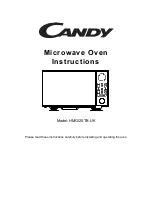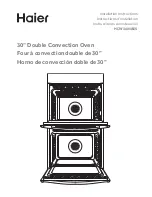
follow all directions. Check the food in several places. Conventional
thermometers may be used on microwave food once the food has
been removed from the oven.
LIMITED USE
Aluminum foil
—
Use narrow strips of foil to prevent overcooking of
exposed areas. Using too much foil can damage your oven, so be
careful. You should keep distance of 1 inch (2.54cm) between
aluminum foil and cavity.
Ceramic, porcelain, and stoneware
—
Use these if they are
labeled "Microwave Safe". If they are not labeled, test them to make
sure they can be used safely.
Plastic
—
Use only if labeled "Microwave Safe". Other plastics can
melt.
NOT RECOMMENDED
Glass jars and bottles
—
Regular glass is too thin to be used in a
microwave. It can shatter and cause damage and injury.
Paper bags
—
These are a fire hazard, except for popcorn bags
due on food.
Styrofoam plates and cups
—
These can melt and leave an
unhealthy residue on food.
Plastic storage and food containers
—
Containers such as
margarine tubs can melt in the microwave.
Metal utensils
—
These can damage your oven. Remove all metal
before cooking.
Note:
Should you wish to check if a dish is safe for microwaving, place the
empty dish in the oven and microwave at high power level for 30
seconds. A dish which becomes very hot should not be used.
PRODUCT DIAGRAM
1. Control Panel
2. Display Screen
3. Door Button
4. Oven Window
5. Top Heating Element
6. Upper Convection Fan
7. Glass Turntable
8. Roller Ring
9. Shaft
10. Baking and Roasting Pan
11. Air Fry Kit
12. Wave Guide (Please do not remove the








































